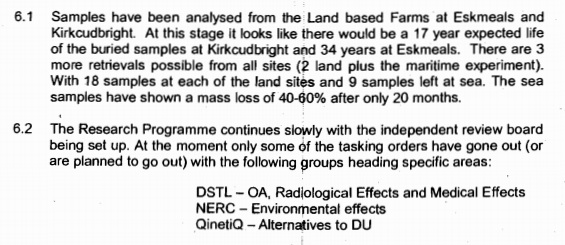October 2002 – February 2004
Here are excerpts from the Minutes of the meetings of the Depleted Uranium Firing Environmental Review Committee which relate to the firings at at the Kirkcudbright Range, near Dundrennan, Dumfries and Galloway.
An introduction to these Minutes is here.
Acronyms:
KTA, Kirkcudbright Training Area, Ministry of Defence (MOD)
DERA, The Defence Evaluation and Research Agency, established in April 1991 as part of the MOD. In July 2001, DERA was split into two organisations:
QinetiQ, a privatised commercial company, and
DSTL, Defence Science and Technology Laboratory (MOD)
RO, Royal Ordnance
BNFL, British Nuclear Fuels Ltd.
EA, Environment Agency
SEPA, Scottish Environment Protection Agency
DTEO, Defence Test and Evaluation Organisation (MOD)
PLSD, Protection and Life Sciences Division (MOD)
CDA, Centre for Defence Analysis (MOD)
D SEF Pol, Directorate of Safety, Environmental and Fire Policy (MOD)
DG(Nuc), Director General (Nuclear) (MOD)
DUWG, Depleted Uranium Working Group (MOD)
Excerpts from Minutes of the 31st Meeting of the Depleted Uranium Firing Environmental Review Committee (DUFERC) on 22 October 2002
As there were no firings in the period since the last meeting, and there are no current plans to fire any more DU at the moment, there was nothing to report from the Range … Already the Army will need to increase costings to the DRPS to pay for the sampling (which is subsequently subcontracted to QinetiQ). Any increases in the sampling would need even more funding.

Full text here.
Excerpts from Minutes of the 32nd Meeting of the Depleted Uranium Firing Environmental Review Committee (DUFERC) on 18 February 2003


Full text here.
Excerpts from Minutes of the 33rd Meeting of the Depleted Uranium Firing Environmental Review Committee (DUFERC) on 24th June 2003

A question was raised asking whether DU projectiles corrode differently after being fired. (Redacted name) replied that these penetrators are affected by firing them. Apparently unfired projectiles initially corrode much fast, however, this corrosion process falls off in keeping with the same corrosion rate as that of fired projectiles. It must be pointed out that corrosion resistance has only been properly checked for projectiles held in storage. No such study has taken place for fired penetrators.
Full text here.
Excerpts from Minutes of the 34th Meeting of the Depleted Uranium Firing Environmental Review Committee (DUFERC) on 5 November 2003

A presentation had been made to the Scottish Executive (SE) and SEPA on the DU issue at Kirkcudbright. included within this was a proposal to reduce sampling to once a year and combine samples for analysis purposes … At the same presentation, SE and SEPA offered to take over the marine sampling programme within the Solway Firth. Whilst it was not clear who would shoulder to costs for such activity by SE or SEPA, there were considered to be clear public perception benefits with the sampling being undertaken in this way.
Full text here.
Excerpts from Minutes of the 35th Meeting of the Depleted Uranium Firing Environmental Review Committee (DUFERC) 11 February 2004
Kirkcudbright report: There had been no DU firings since the last meeting.

Full text here.


